A qualified technician will come to your home or business and install the Backflow Prevention Device based on the manufacturer’s guidelines.
Backflow Preventer Installation
Backflow Preventer Installation
Installing your backflow preventer is critical for protecting your water system and supply from contamination, but it can be challenging to undertake the installation process independently. Many people leave this type of project in the hands of experienced professionals.
This post will outline the important steps in installing a backflow preventer, so you know what kind of services and expertise should be sought when hiring contractors to complete the job correctly.
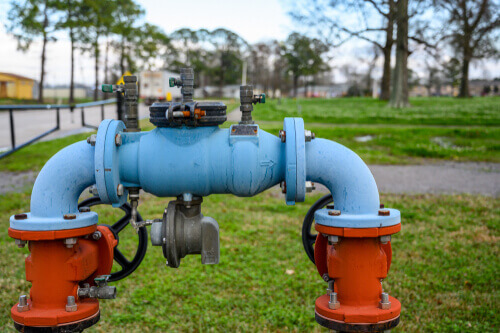
Do you want to protect your family and home with a backflow preventer installation from Blackmon Inc.?
The own backflow preventer is the best way to ensure that your family has access to clean water, no matter what. We can install one for you in no time, so you can rest easy knowing that your water is safe.
Not only will a backflow preventer keep your family safe and healthy, but it will also help protect your home from damage.
Whether you’re looking for information about why you need to invest in such protection or want an overview of what needs to be done during installation, we have all the information you need!
Please schedule an appointment today, and let us take care of everything for you. You won’t regret it!
Overview of Backflow Preventers
A backflow preventer is an important part of a plumbing system that helps to keep drinking water safe from contaminants. It prevents the reverse flow of contaminated water from entering the public water supply. Backflow prevention devices are required in all commercial, institutional, and industrial buildings and some residential homes.
Backflow preventers come in various types and sizes, depending on the needs of the specific building. Most backflow devices are made of brass, stainless steel, or some other corrosion-resistant material. They can be installed vertically or horizontally in different environments, such as basements and crawl spaces.
Here are the four types of backflow preventers commonly used in water systems:
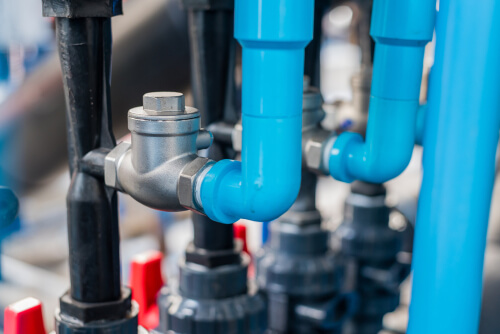
Atmospheric Vacuum Breaker (AVB)
Atmospheric vacuum breakers are considered the most basic form of a backflow preventer. This device is often used for irrigation systems and other non-potable water sources to protect against contamination. The AVB is the simplest type of backflow prevention device, with no moving parts or valves required for operation. It operates on atmospheric pressure, using air in the system to backflow occurs to break.
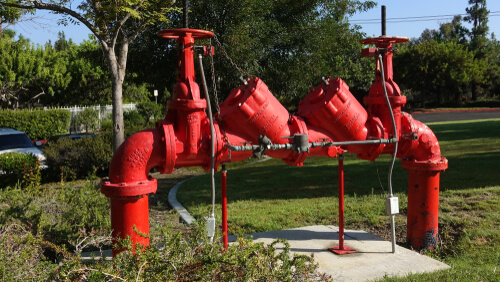
Double Check Valve Backflow Preventer (DCV)
Double-check valve preventers are a more complex form of the AVB and are typically used for residential and commercial applications with higher water pressure. They use two sets of independently operating check valves, each set placed in a different direction, to provide a higher level of protection against backflow.
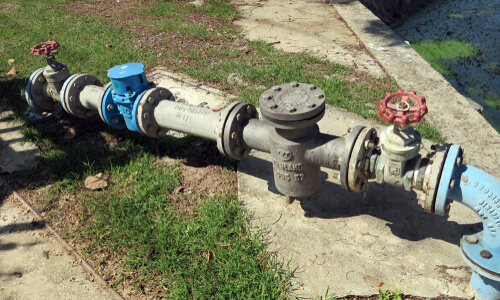
Reduced Pressure Principle Backflow Preventer (RP)
The RP is the most complex form of backflow prevention used in commercial and industrial water systems. It contains two independently operating check valves and a relief valve to ensure the water pressure stays within acceptable levels. This type of device is often used for healthcare facilities and other applications that require a higher level of protection.

Pressure Vacuum Breaker (PVB)
Pressure vacuum breakers are similar to atmospheric vacuum breakers but have some additional features, such as an air inlet valve and a pressure relief valve. These features allow the PVB to protect against both backflows caused by pressure and atmospheric changes.
Backflow preventers are essential for protecting the public water supply from contaminants and should be installed in any building or system with a potential risk of contamination. To ensure that your backflow prevention assemblies are properly installed and maintained, it’s important to consult a professional plumber or backflow specialist.
The Backflow Prevention Device
It is one of the most important components of a plumbing system. It helps protect your drinking water supply from potential contamination or pollution by preventing non-potable or contaminated water from flowing back into the main water supply line. Installing a Backflow Prevention Device is essential for any home or business that has an outdoor irrigation system, swimming pool, hot tub, or other sources of non-potable water.
Backflow preventers come in various sizes, styles, and materials to fit your needs. They are typically installed on the main water supply line, near the source of contamination or pollution. The Backflow Prevention Device prevents contaminated or polluted water from flowing into the main water supply line. It also helps protect your drinking water supply from contamination or pollution by preventing non-potable or contaminated water from flowing back into the main water supply line.
Here are the Blackmon Inc offers professional backflow preventer installation services:
With Blackmon Inc Backflow Prevention Device Installation Services, you can trust that your drinking water supply is protected from contamination or pollution.
What are the important cost factors of installing a Backflow Preventer?
Several factors come into play when considering the cost of installing a backflow preventer. The most important factors to consider are:
Considering all these factors when calculating the cost of installing a backflow preventer, you can ensure you get the best value for your money. It is important to research and compares different types and sizes of backflow preventers to find the best fit for your needs.

How much is the cost of Backflow Preventer Installation?
The cost of backflow preventer installation can vary depending on several factors. This includes the type of backflow preventer needed, local labor costs, and installation difficulty.
Generally, the average cost for a basic residential backflow preventer installation is between $300-$600. More complex or commercial installations will likely have higher costs. It is recommended to get quotes from local professionals for a more accurate estimate. Some plumbing companies may offer discounts or package deals if multiple services are requested simultaneously.
In addition to the costs associated with installation, maintenance and repair fees should be considered when deciding to install a backflow preventer. Depending on the type of sewage system fills, annual maintenance may be necessary. This could involve inspection, testing, or repairs to ensure the proper functioning of the backflow preventer. Prices for these services can range from $50-$200 on average.
A Quick Guide to Installing a Water Backflow Preventer
If you want to protect your water supply from contamination and other problems, installing a backflow preventer is an important step. This guide will help you understand the basics of installing a backflow preventer in your home or business.
The Benefits of Installing a Backflow Preventer
Backflow preventer to the rescue! Installing your backflow preventer can provide multiple benefits for your home or business.
Here are five reasons why you should consider installing one:
These are just a few of the benefits that come with installing a backflow preventer.
5 tips for Backflow testing and maintenance
When you have a backflow preventer installed on your property, it’s essential to regularly inspect and test it to ensure it is working correctly.
Here are some tips for effective backflow testing and maintenance:
By following the tips above, you can ensure that your backflow preventer is functioning correctly and keeping you safe. If you have any questions or concerns about backflow testing and maintenance, it’s best to contact a certified technician for advice.
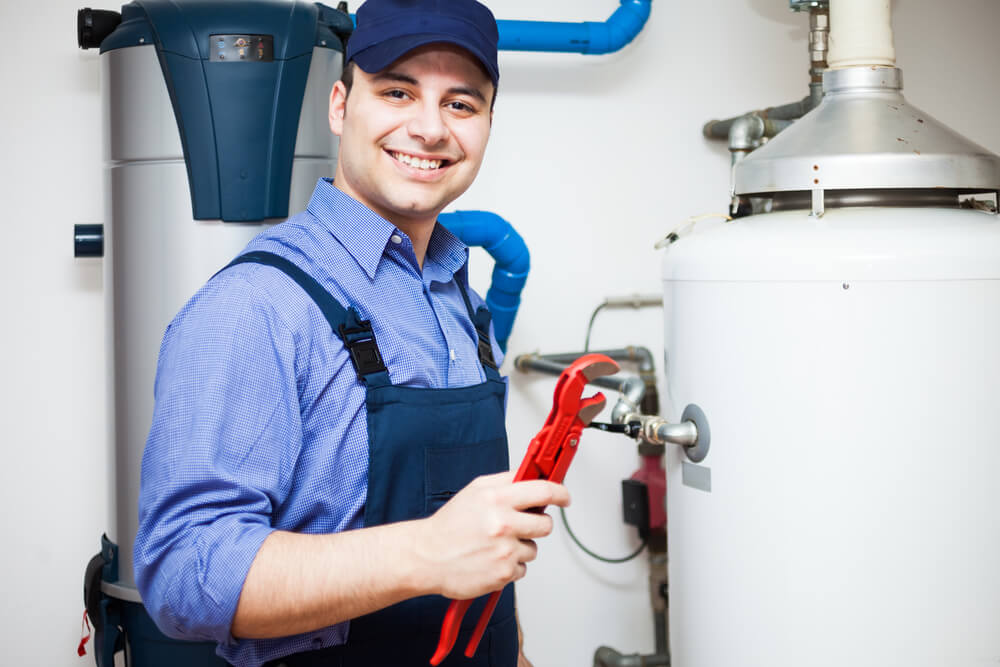
Final Thoughts
Blackmon Inc. has shown numerous benefits to installing a backflow preventer on your property. Not only will it protect the safety and health of your family, but it can also save you money in the long run. The peace of mind of knowing that any potential contamination from unsanitary water sources has been prevented is invaluable.
If you’re considering having a backflow preventer installed on your property, contact Blackmon Inc. today for a free consultation and estimate. Let us help you protect the health and safety of your family. We hope this article has helped provide some background information and answer any questions you may have about the importance of backflow preventer installation. Thank you for reading, and we look forward to helping you out!
Frequently Asked Questions about
Backflow Preventer Installation.
Can I install my backflow preventer?
No, you must hire a professional certified in backflow preventer installation to ensure proper installation and safety. Improper installation can lead to serious health risks, so the job must be done correctly.
Where should a backflow preventer be installed?
A backflow preventer should be installed as close as possible to the point of connection between a potable water supply and any non-potable source. It is important to ensure that the backflow preventer is always upstream from any potential sources of contamination.
Can a plumber install a backflow preventer?
Yes, a plumber can install a backflow preventer. However, it should be noted that some states require plumbers to be certified in backflow prevention assembly before they are allowed to install the device. It is important to check with your local regulations before having any work done.
Do I need a backflow preventer?
Yes, backflow preventers are essential in protecting the public water supply from contamination. Without a backflow preventer, there is a possibility that contaminants could travel backward through the pipe and enter the drinking water. It is important to ensure this does not happen by having a professionally installed backflow preventer.
